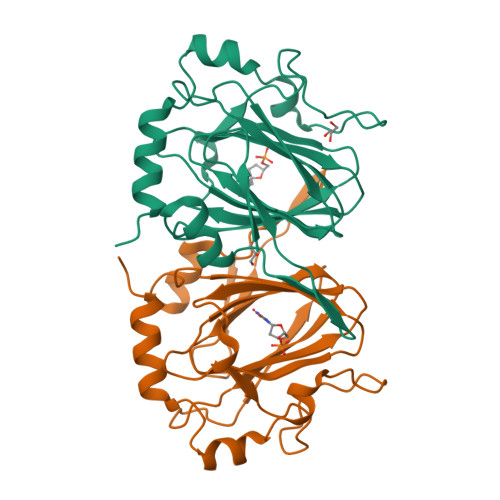The Position of a Key Tyrosine in Dtdp-4-Keto-6-Deoxy-D-Glucose-5-Epimerase (Evad) Alters the Substrate Profile for This Rmlc-Like Enzyme
Merkel, A.B., Major, L.L., Errey, J.C., Burkart, M.D., Field, R.A., Walsh, C.T., Naismith, J.H.(2004) J Biological Chem 279: 32684
- PubMed: 15159413
- DOI: https://doi.org/10.1074/jbc.M404091200
- Primary Citation of Related Structures:
1OI6 - PubMed Abstract:
Vancomycin, the last line of defense antibiotic, depends upon the attachment of the carbohydrate vancosamine to an aglycone skeleton for antibacterial activity. Vancomycin is a naturally occurring secondary metabolite that can be produced by bacterial fermentation. To combat emerging resistance, it has been proposed to genetically engineer bacteria to produce analogues of vancomycin. This requires a detailed understanding of the biochemical steps in the synthesis of vancomycin. Here we report the 1.4 A structure and biochemical characterization of EvaD, an RmlC-like protein that is required for the C-5' epimerization during synthesis of dTDP-epivancosamine. EvaD, although clearly belonging to the RmlC class of enzymes, displays very low activity in the archetypal RmlC reaction (double epimerization of dTDP-6-deoxy-4-keto-D-glucose at C-3' and C-5'). The high resolution structure of EvaD compared with the structures of authentic RmlC enzymes indicates that a subtle change in the enzyme active site repositions a key catalytic Tyr residue. A mutant designed to re-establish the normal position of the Tyr increases the RmlC-like activity of EvaD.
Organizational Affiliation:
Centre for Biomolecular Sciences, The University, St. Andrews, Scotland, KY16 9ST, United Kingdom.


















